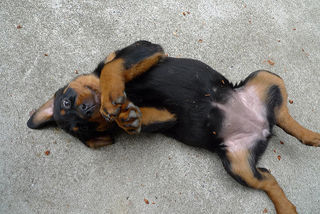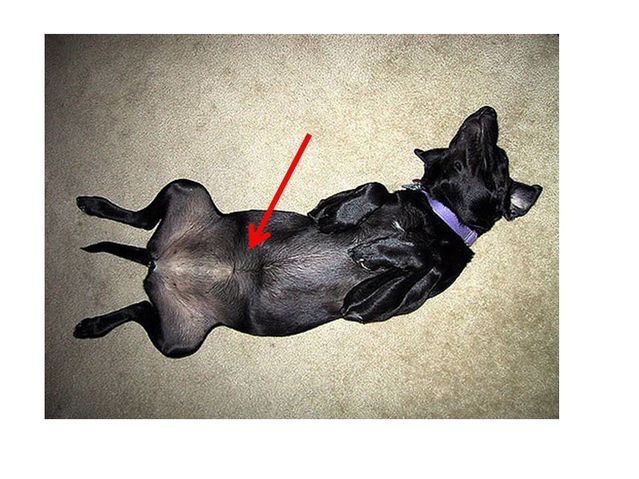Pregnancy
Do Dogs Have Belly Buttons?
Dogs do have belly buttons but they may be hard to find.
Posted March 7, 2019 Reviewed by Ekua Hagan
I was sitting in a Greek restaurant having dinner with an old friend of mine. We were just finishing up, sipping Greek coffee and ouzo when a wall-mounted speaker began to play an upbeat Mediterranean piece of music.
At that moment, a belly dancer appeared and began to move around the room. She was a pretty girl, dressed in the kind of costume you expect belly dancers to wear — festooned with bright metal discs that made a jingling sound as she gyrated to the music. Her torso was bare, and as she danced past our table, we could see that her navel was pierced, and the piece of jewelry she wore there had a set of gold bangles that swished around as she danced.
When she finished her performance, the music stopped and she ducked out of the same door that she used to enter.

At that point, my friend leaned over to me and said, "That was a lot of jewelry that she had hanging from her navel. It made me wonder about something which I don't think I ever considered before. Do dogs have belly buttons?"
Human navels, or belly buttons, are simply scars left over from where we were connected to our umbilical cords during gestation. While still in the mother's womb, a baby receives food and oxygen and rids itself of waste through that umbilical cord. One end of the cord is attached to the middle of the baby's stomach and the other end of the cord is attached to the mother's placenta. This placenta is an organ that develops during pregnancy specifically to handle these special tasks. Once the baby is born and begins breathing on its own, the umbilical cord is cut and tied off. After a few weeks, the remains of the cord wither away and all that remains is what we call our belly button.
This process is not unique to humans, since all mammals share similar processes during development and birth. There are two exceptions. The marsupials (pouched animals like kangaroos and possums) also have a uterus and placenta, however their placenta is more like a yoke sac and the marsupial baby is attached to it for an extremely short time. The baby then moves to the pouch and from there on gathers its nutrients from its mother's teat while it finishes its development, and meanwhile the umbilical cord simply disappears.
The other exception is found in the very rare animals known as monotremes. These are egg-laying mammals like the platypus. Obviously, with no umbilical connection, there will be no umbilical scar and no belly button. However all other mammals do develop with an umbilical cord connecting them to their mother and therefore they have belly buttons.
In the case of dogs, each puppy is born in a fluid-filled sac; however, it is still connected to its mother's placenta via an umbilical cord. Once the puppy is out of the uterus, the mother dog will immediately bite and break off each of her offspring's umbilical cord. In one to three days, the stump of the umbilical cord dries up and falls off, soon leaving just a scar. You can get a better idea of what is happening by looking at this photo of three newborn Golden retrievers.

Generally speaking, the dog's resulting belly button is not obvious beyond puppyhood for several reasons. The size of the canine umbilical cord is small. In order to sustain a human baby, a larger umbilical cord is required, and that, of course, means a bigger scar. The puppy's umbilical scar heals into a small slit, rather than a round hole. Furthermore, this area is soon after covered with fur, which makes it more difficult to find.
The dog's belly button does not look like the human belly button. We have innies (like a little hole or pit) and outties (like a little bump). For dogs, the belly button is generally just a flat scar, (never an innie) and if it is seen to protrude beyond early puppyhood, it might be a sign of a problem such as a hernia or a poor closure of muscles.
So how do you find your dog's belly button? It should be located in the middle of the dog's abdomen, just under where the rib cage ends, and just above an imaginary line marking the top of the pelvis. For most dogs, it will look like a small flat vertical scar, or perhaps a circular or oval wrinkle on the skin. In some cases, the hair on the dog's stomach may even swirl or form a tuft near the belly button area. Sometimes, it is easier to find it by pressing your fingers around that region, since it is occasionally hard to see it even if you get the right location. To your probing fingers, it should feel like a bit of firm tissue just beneath the skin (since the canine belly button is just a small knot of scar tissue).

Dogs pay little attention to their own belly buttons; however, some dogs seem to be fascinated with human belly buttons, especially those which are the innie variety. That small little pit in the middle of your abdomen not only attracts lint, but also traps sweat. So if you sweat a bit, it might lead to the buildup of enough of a scent to attract explorations by your dog's nose and tongue.
After I had explained the basics of navels on dogs to my friend, I quipped, "At least dogs are not really vain about their belly buttons, and since they are hard to find, I doubt that anybody is going to try to pierce a dog's navel to hang some flashy jewelry from it like we saw that pretty dancer wearing."
Unfortunately, I was wrong. The following morning, my friend sent to me the URLs for a few news stories. These talked about the fact that in 2014, the state of New York felt that the issue of animals being pierced in order to allow them to wear jewelry on their ears, and yes, their belly buttons, had reached a point where it required the state to pass a law banning the procedure.
Copyright SC Psychological Enterprises Ltd. May not be reprinted or reposted without permission




